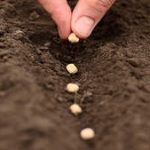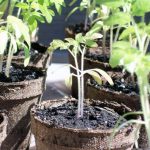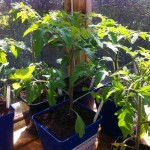And so it begins. Another season starts with the determined act of seed sowing in the potting shed. A bag of compost opened and tipped out on the sowing bench. Cold black plastic pots filled with even colder blacker compost. Seed labels lined up awaiting a scrawl of information. Seed packets fished out from my big box of tricks and ripped open to reveal their bounty. It’s just tomatoes, aubergines and peppers today so five tiny little seeds are placed gently on the surface of each pot (one for each variety I will sow and 17 pots in all).
Ah but it feels good to start again in to another season. While I work I try to remember whether it’s my tenth or eleventh season? Then I find myself wondering how many seasons I have ahead of me. Maybe thirty if I am lucky? I pull myself back from such existential thoughts and try to stay in the moment. I plug in the heated cable to start the process of warming the sand beneath the seed pots. I realize I am whistling.
It feels too cold to be sowing seeds. The calendar says spring (in that strange Irish way that labels February spring) but it’s definitely still winter outside. All day the weather has alternated erratically from sun to cold showers of rain. I have shelter from the elements in here in the potting shed but I can feel my feet are numb in my wellies and the tips of my fingers are cold. I’ve a hat on my head and several layers of fleece beneath my jacket, and I can see my breath while I work. I would like to luxuriate over this process, particularly today since it’s the first sowing of the year, but it’s too damn cold—so I move quickly. Sow a pot, label it, move on to the next one.
Before I finish I make a cloche over the pots with some rubber pipe and spread a layer of clear plastic over them, tucking the plastic in beneath them. I am creating a little hothouse for these seeds, which need heat to germinate. It feels a little artificial, but my growing year always starts like this—coaxing Mediterranean conditions from a cold February and trying to warm up the world.
Things to Do This February
Turn over the soil only if the weather is dry—if the soil sticks to your boots it’s too early for digging!
Keep off the soil to prevent soil compaction—use timber planks to stand on for access. If you have not already done so order/buy your seeds, spuds and onion sets. Chit or sprout seed potatoes—put them in a container (e.g. used egg carton or empty seed tray) and leave them in a bright warm place.
Check the pH of your soil—you can buy a soil pH testing kit in any garden centre. Lime your soil now if required (to reduce acidity in very acid soils), particularly important in your brassica bed.
Finally, we can sow some seeds. On a sunny windowsill indoors, in a heated greenhouse or on a heating mat: sow celery, globe artichokes, celeriac, leeks, onions, lettuce, tomatoes, peas, aubergines, peppers/chilli-peppers. In polytunnel or greenhouse: beetroot, Brussels sprouts, summer and autumn cabbage, carrots, leeks, lettuce, radish. Outside: Weather permitting you can try planting out broadbeans, spinach, kohlrabi, onion and shallot sets, Jerusalem artichokes, parsnip and early pea varieties.
Harvest: Winter cabbage and cauliflowers, Brussels sprouts, spinach, kale and leeks.
Recipe of the Month—
Chocolate and Beetroot Cake
GIY Dorset local champion Wendy Pillar put together a handy guide to beetroot recipes, which I happily plagiarise here (with thanks!)—this Pam Rosling recipe for chocolate and beetroot cake is delicious and easy to make.
Ingredients
- 100ml rapeseed or sunflower oil
- 220g cooked beetroot
- 150g soft brown sugar
- 1 tbsp baking powder
- 50g cocoa powder
- 200g natural yoghurt
- 2 tsp vanilla extract
Heat oven to 180°C/160°C fan/gas 4. Grease and line a deep 2cm springform cake tin. Tip the beetroot into a food processor and whiz to a puree. Add the remaining ingredients, along with a pinch of salt, and blend until well combined. Scrape into the cake tin, level the surface and bake for 50 min to 1 hour, or until a skewer comes out clean.
Tip of the Month—
Make a Spring Nettle Tea
Wild nettles are a free, abundant wild food that are traditionally used to purify the blood and digestive system. They are one of nature’s first spring foods and will give your immune system a boost. Go in search of fresh spring nettles to make a tonic—use gloves and pick only the tender, pale green leaves. Use a scissors and cut off the top two bracts of leaves, leaving the rest to grow back. Put about a cup of nettle leaves in to about two cups of boiling water and leave for 10 minutes. Pour through a strainer in to a mug and add honey to taste.
Join GIY
By joining GIY you help us to continue the work of supporting people just like you to grow food at home, at school, in the workplace and in the community—this year we will support over 150,000 people and 5,500 community food growing groups and projects. It costs just €35 to join GIY for a year, and to say thanks we will send you a seasonal copy of our supporter’s magazine GROW and some GIY seeds for you to sow each quarter. We will also send you our weekly tips, news and advice e-zine and offer you discounts to GIY events like the annual GROW Fest. Join today at GIYireland.com.
Michael Kelly is a freelance journalist, author and founder of GIY.
© GIY Ireland 2016—all rights reserved.




